- Animals, Chickens, Cob, Compost, Composting toilet, Fruit, Gardening adventures, Giving, Grains, Health, Herbs, Houses, Hugelkultur, Humor, Living structures, Natives, Natural cleaners, Permaculture and Edible Forest Gardening Adventures, Ponds, Rain Catching, Recipes, Seeds, Soil, Vegan, Vegetables, Vegetarian, Worms
San Diego Permaculture Convergence, Nov. 9 – 10, 2013
There is a fantastic, information-packed permaculture convergence coming up at the beautiful Sky Mountain Institute in Escondido.
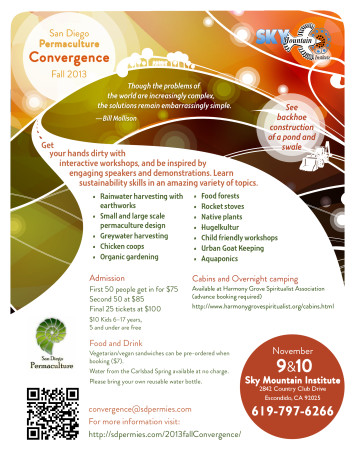 It will be two days packed with great information for a very reasonable price; in fact, scholarships are available. Check out the website at convergence@sdpermies.com. On that Sunday I’ll be teaching a workshop about why its so important to plant native plants, how to plant them in guilds using fishscale swales and mini-hugelkulturs. Come to the convergence and be inspired!
It will be two days packed with great information for a very reasonable price; in fact, scholarships are available. Check out the website at convergence@sdpermies.com. On that Sunday I’ll be teaching a workshop about why its so important to plant native plants, how to plant them in guilds using fishscale swales and mini-hugelkulturs. Come to the convergence and be inspired! -
Fruit Tree Guild, Revisited
In June I blogged about how to plant a fruit tree guild, and gave the example of one I was planting by the Fowl Fortress. I thought I’d show you how it matured.

Apple tree in trouble: heavy clay thoroughly shot through with Bermuda grass. Yuck! This was the area four months ago. Heavy, sticky clay taken over with Bermuda grass. A struggling apple tree begs for my help. A star jasmine climbs the side of the Fowl Fortress. A portion of the brown subterranean irrigation system lies aboveground.
Using permaculture design, I created a plant guild with herbs and vegetables that would build the soil and help the apple tree.

A guild is planted. Strawberries went around the trunk of the tree for groundcover and grass competition. Comfrey, a valuable nutrient accumulator in there, too, for slash and drop fertilization. There is also a perennial basil, marjoram, gourds, golden runner bean (a nitrogen fixer), garlic chives, a prostrate rosemary and a tomato, along with other flower seeds. This is how it looks now from the same vantage point:
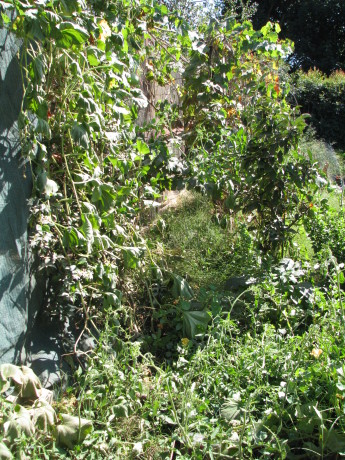
The guild in September. 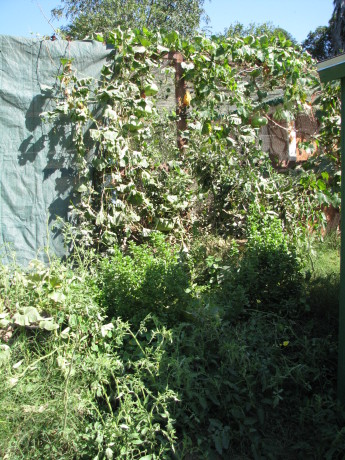
Layers of plants protect the ground and produce food. 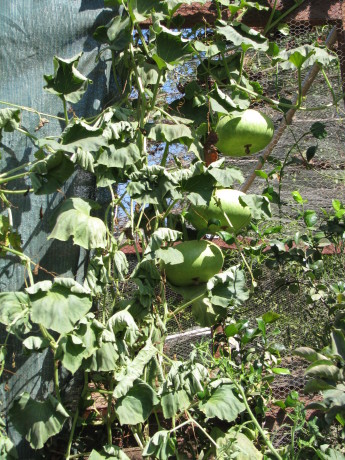
These gourds can be dried and made into bowls. 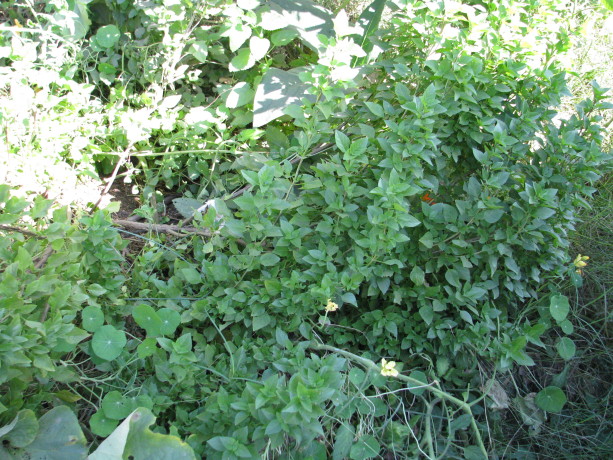
Perennial basil, Amish paste tomatoes smother the weeds and enrich the soil. 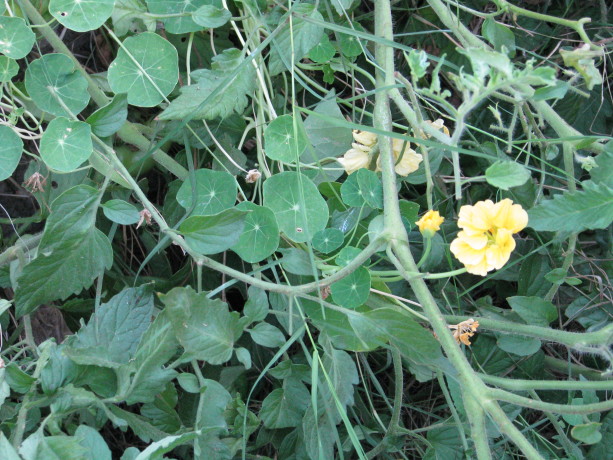
Nasturtiums reseed and fill in as the other vegetables die off. Polyculture beds produce abundant, insect-confusing food guilds which help fertilize and water each other and improve the soil quality. Meanwhile the apple tree has a few apples on it and looks healthier than it has been. Next year’s growth should be drastically improved, and the amount of invasive grasses should be nil. If I don’t grow consecutive annual crops here around the perennial plants, I will sheet mulch the bed.
-
Going Pooless
I’ve been pooless for almost a week. I know, I know, who would have thought that I would do it? I’m sure if my friends knew, they wouldn’t know what to make of it. Even when my daughter called and I told her that I’d been pooless for several days, there was a surprised silence for several moments. In fact, I’ve been around friends, on a consultation job, and out shopping, and no one noticed. I was proud enough of my resolve to reveal my poolessness to a group of teachers who had just completed a 2-hour tour of Finch Frolic Garden last Saturday. After all the cool permaculture things I’d been showing them, their looks of astonishment were no surprise to me.
Why have I gone pooless? Because I’ve heard about how good it is for your skin, your hair and how it combats allergies. It is also inexpensive and easy on the greywater system.
Going without shampoo has been an interesting experiment.
The term ‘going pooless’ was popularized by permies.com lecturer Paul Wheaton. He has a podcast and discussion board about it here if you’d like to hear his and a woman’s year-long account of going soapless, as well as many other comments from people who have been soapless, shampooless and deodorantless for years.
The reason for going pooless is that we shampoo far too much. Shampoo strips away all the natural oils along with the dirt, and then we put more (usually expensive) gook on our hair to make it soft and shiny again. All that gook has lots of harmful chemicals, additives and scents. Commercial shampoos and soaps are dramatically linked to exema and other severe skin problems, allergies, and even migraines. I know several people who have to have ultraviolet treatment on their skin to keep psoriasis in check. One of these people is a clean fanatic, and another dyes her hair and wears a lot of makeup and perfume. I’ve mentioned going pooless or soapless to several people with skin problems, but they’d rather go on doing what they’ve always been doing.
Last week a good friend cut my hair (for barter) and it is short. It had been long enough that I’d been using a little hairspray to keep it out of my face and even when I washed my hair there was a residual product feeling to it. I washed my hair with Dr. Bronner’s castile peppermint soap, and still feeling some product I rinsed with diluted apple cider vinegar. That left my hair soft and clean. I always wash my hair in my morning shower. I continued to do that but instead of using shampoo, just vigorously rinsed it with plain water. This was a challenging time to do this because we entered a heat wave with temperatures rising over 100F, and I gardened, weed-whipped and sweated all through it. I also have the tendency to run my fingers through my hair.
The first couple of days I noticed no difference in my hair after rinsing. Gradually over the weekend my hair began to feel heavier, but it didn’t look greasy (I have oily skin type). I had heard that some people with straight hair who went pooless actually ended up with wavy hair – this was a strong motivator for me, but I’m out of luck. Yesterday I worked in the morning for several hours in the heat outdoors with a hat on, then dragged myself through my shopping chores. I encountered some challenging people and wasn’t in a great mood in the evening. I really like clean hair, too, and my hair was going through the transition stage of adapting to natural oils. It didn’t feel right. So this morning I rinsed it as usual, but also used a very tiny bit of natural shampoo for a quick rinse. I felt guilty about abandoning my project, but when I got out of the shower my hair still felt as if the natural oils were there, but my hair felt lighter. I didn’t strip it, but probably got rid of some extra oil from the extremely hot days. There is an adjustment period with going pooless. After some time your hair adjusts to absorbing the natural oils and then levels out and looks and feels great. Many European women rinse their hair and rub olive oil into it, leaving it in their hair. Their hair is luxurious. Allowing your own body’s oil to do the same thing is even better.
The purpose of soap is just to break the surface tension of water (surfactant) so that water penetrates better. All the rest of the stuff in soap is extra. Some of it can be good, like the addition of oatmeal to soothe skin or pieces of lavender to exfoliate. Many plants – like soapwort – are surfactants. We don’t need to use the harsh chemicals that are in most soaps to do the job. In fact, we really don’t need the soap at all except occasionally. If you don’t want to just rinse your hair with water but would like a more natural solution, dissolve some baking soda in water and use that the way you would soap. Your hair will feel sticky and tangly. Then rinse your hair with diluted apple cider vinegar (or white vinegar). Your hair will be soft, shiny, smooth and lovely because the acid will have neutralized the alkaline baking soda. A vinegar rinse every now and then helps strip product out of your hair anyway.
Going without deodorant or soap are two other venues to investigate, especially if you have any kind of skin issues or recurring headaches. Read some of the testimonials on the permies.com podcast page, or elsewhere on the Internet. Or use more natural ingredients to see what works for you.
I will continue to go pooless, with an occasional light sudsing from a natural shampoo when I feel the need, but I’ll be careful not to strip out the natural oil. If anyone compliments me on my hair, I will be proud to advertise my poolessness!
-
Arthritis and Turmeric… What Helped For Me
I’ve had osteoarthritis in my hands for almost fifteen years. I blame all that weed-whipping, pick-axing clay soil, and carrying all the plastic grocery bags in all at once because, by God, I’m not going to make two trips! It has migrated to my back, feet, ankles, and by the way I’m feeling these days my hip. I’m 51 years old. I’m also going through those lovely years of change that women get to experience, which makes my memory more dicey than I’m comfortable with, and some of that is due to my bad back (which I’ve had since a fall on a tennis court when I was 10 snaked my back) and the way I hold all my tension in my shoulders and neck. I’m sure that the tension and slowing of blood circulation that happens between trips to the chiropractor makes me a little ditzier than usual, too.
I’ve been taking glucosamine and chondroiten since my hands first gave me trouble. It worked wonderfully for years, and I’m sure it still does. When I moved to this house – I did all the packing and moving for me and my children – I found that my hands hurt so badly from carrying boxes that I didn’t know how I was going to use unpack or go back to work after my week’s vacation was up. By taking glucosa mine and chondroiten my hands felt better within a couple of days and I was able to continue.
Move through time with me to 2011 when my permaculture garden was installed. I had to drag multiple lengths of water-filled hoses around, haul heavy pots of plants and trees, dig through heavy soil and pull weeds. After it was installed, the next year, I had to dig out the huge rootballs of invasive bamboo that had been planted and replant trees, all of which had been planted deeply in clay inside gopher cages. Oh, and pull weeds. Lots of weeds. Glucosamine and chondroiten weren’t helping with the inflammation, just the lubrication of the joints. My hands hurt so badly that I was in crisis mode, wondering how I was ever going to keep the garden going when I couldn’t even use my hands for a day after pulling weeds. I’d wake up and my hands would be locked partially closed. I’d have to force them open, the fingers clicking as they ratcheted up, and then work them until the joints lubricated. My back hurt a lot. My mind was often in a fog and taking ginko biloba helped only a little. I became very depressed, wondering how life was going to be for me when at fifty I was in that bad a shape, and longevity (but not mental clarity!) was on my mother’s side.
I’d been taking a healing yoga class, and added that when I could two fitness classes a week at the marvelous Wade Into Fitness classes at the local community center. The gentle yoga practice kept me limber and steady, and helped me keep working, yet the artritis pain was still there.
As usual, I already knew the answer but didn’t realize it. I learned from MindZymes.com that the curcumin in turmeric, a spice used in curries, was an anti-inflammatory, so I’d been sprinkling it on my food. Using a lot tastes very bitter and the spice doesn’t go with everything. I’d read that black pepper helps to increase the absorption so I paired them together. No breakfast egg went eaten without being turned yellow and black. Then one day I researched turmeric thoroughly. Turmeric is prescribed by doctors in India like a drug, yet it is completely natural. The warnings for using it include that it may thin blood, may interfere with gall bladder (I had mine out a few years ago), and it hasn’t been tested (in the US) enough to be sure that it is safe for pregnant and lactating women. I read that all illness involves inflammation. Taking an anti-inflammatory can help with all illnesses. Wow. Sprinkling turmeric on my food was fine, but it wasn’t a large enough dosage to help with the inflammation I already had; I’d have to take capsules.
I was skeptical but I was ready to try anything rather than get shots from the doctor, or give up my activities. I’d just invested in this wonderful garden and I could hardly work in it. I bought turmeric capsules at a local herb store. It included phosphatidylcholine, which is a vital component of the human cell membrane and has been proven to play a vital role in our health, including maintaining cell structure, fat metabolism, memory, nerve signalling and liver health. the curcumin in turmeric is difficult for the body to absorb on its own, so the phosphatidylcholine helps increase the absorption by 70%. No, I didn’t know any of this before, I looked it up.
Last September I included the capsules with my daily vitamins and didn’t really think about them anymore. Within a few weeks I realized that when I awoke my hands weren’t stiff and stuck into position anymore. In fact, they didn’t even ache much after a day of weeding. The arthritis would cause shots of pain radiating from a knuckle down a finger like a lightening bolt, coming on without warning and making me gasp, something not fun when out in public. I realized I hadn’t had any of those surprise episodes for awhile. I also realized that when I went to my memory banks to search for a name, often I’d come up with it right away. My memory has never been perfect, but it was functioning better than it had and I felt less stupid and old. The reason for these miracles had to be the turmeric, because nothing else in my diet had changed. I continued taking it, and tested myself. I’d pull weeds, carry groceries and wake up the next morning with only the usual middle-aged aches and pains.
It has been nine months that I’ve been taking turmeric with phosphatidylcholine and every morning I wake up wondering if the spell has been broken. But it hasn’t. I even weed whip for hours and although I’m sore the next day, my hands aren’t locked and they are fully usable. Turmeric isn’t a miracle herb as such; there is no such thing. I still take a minute to loosen up my ankles and back when I get up in the morning, and heaven knows my memory makes conversations with other middle-aged people an exchange of “Um… you know… that thing…”; often more like charades than a dialogue. I still have to be careful and pace myself because the arthritis is still there. However I’m functioning far better than I was a year ago. My hands work!
I’ve recommended turmeric to lots of people, and I’ve had a couple of them tell me that they’ve found improvement since taking it. As I said, I was skeptical when I started and the relief I’ve had is frankly wondrous to me. It is not a cure-all, but as an anti-inflammatory it really worked for me.
I do not have anything to do with the company whose brand I buy; I simply bought what was available locally and it worked so I haven’t tried others. I’ve since begun buying it on the Internet because the local store stopped carrying that brand due to a contract dispute or something (of course!), and I get it for much less cost that way. Again, I receive nothing for recommending the brand, but what I’ve been taking is Source Naturals Meriva Turmeric Complex. Meriva is their trademark name for the phosphatidylcholine. I buy it from AmazonSmile.com (where you can designate a charity to receive a very small donation with every purchase), and found a deal for two bottles for a great price.
Anyway, since this really worked for me, I’m passing on my experiences in hope that maybe it can help you, too. Be sure to research turmeric for yourself to make sure that it doesn’t have any interference with problems you may have, and see what the health practitioners in India have to say about it.
And may all your weeds jump out of the ground at your feet!
UPDATE: It is March, 2017, and I’m still taking this turmeric with excellent results. If I over use my hands I’ll take two capsules in the morning. I switched to another brand that didn’t have the gel caps (I’m vegetarian), and it had a different mixture of turmeric, and within a week I was getting shooting pains in my fingers. I quickly switched back to this brand and the pains stopped. I don’t get anything from this company, I just know that this brand works for me. I use a gas weedwhip for hours, pull weeds, and recently bought a battery pole chainsaw which really taxed my hands and arms, and I’m not suffering from it, all due to the turmeric.
-
Home Remedies
I’ve been going to physical therapy for my sprained wrist, and fortunately the therapist is someone who believes in diet and herbs as a viable alternative to or complement of conventional medicine, as do I. We started discussing home cures, and I began to think over how many that I knew because my mother used them. I was born when my parents were in their early forties, and they were born before the 1920’s, before World War II and the scientific revolution. Before everyone turned to petri dishes for the ultimate answers. Medicine made great progress in finding vaccines for heartbreaking diseases such as polio. However, its successes gave it a blanket approval, and suddenly scientists could do no wrong. Many medicines are derived from plants, such as simple aspirin which has the main ingredient salicin that is found in willow trees. Scientists found a way to synthesize salicin so as to put a patent on it and make money, just like so many other drugs. When pharmaceutical companies took hold, that is when we lost control of our traditional medicine and our health. Health is a business, and what is in the drug stores has little to do with getting well, but is mostly about making money. Most medicines treat symptoms and provide enough relief to make you re-buy the product, but won’t eliminate it because then you will have no need to buy it again.
Home remedies have for the most part become lost in the past as post World War II parents disregarded the ‘old fashioned’ methods and turned to the pharmacy. Thus, the traditions were not passed on to their children, so the remedies have been lost. Only in reading old books do we hear them mentioned. Or we can surreptitiously inquire at a health food store, where much of the same buying tactics are at play, and clerks are not medical professionals. The desperation for cures is such that people would often believe strangers rather than doctors, well-written propaganda rather than documented success, and that is dangerous. I was shopping at Henry’s last week, standing with my empty basket looking at the herbal tinctures section, and a woman pops around the corner and holds up a bottle of sesame oil and asks if it would be a good choice to use as a carrier oil for a tincture she had at home. Fortunately for her, I’ve been involved with herbs for thirty years, and I knew what she was talking about, and gave her I think accurate advice and warnings, which included doing some sound Internet research on her own. I don’t know how a short, middle-aged woman with an empty shopping basket would appear to be knowledgeable, but perhaps anyone would have done as well for her.
I have been researching home remedies for reducing inflammation, since my sprained wrist hasn’t healed and I have arthritis and bursitis (wow… just bury me now! What happened to youth?) among other casualties of the physical working life. It made me think of my mother and all the vitamins she gave us and home remedies, as well as enforcing a healthy, balanced diet when meat and potatoes were the standard.
One cure she passed on from her European grandmothers was the mustard plaster for chest colds. Mix dry mustard powder with water to make a paste, put it on an old cloth and slap it on your chest. She used old diaper cloths. I still have them! If you have tender skin or are a child, then a film of vegetable oil on the skin helps protect from the burn. I believe that the way it works is to stimulate blood flow to help the body clear up congestion, and warm up the body to help sweat out the toxins. Capsicum from peppers works the same way in arthritis medicines. Vicks Vaporub replaced the mustard plaster, using menthol from eucalyptus and mints (now synthesized) to clear the sinuses as well as help the chest. The petroleum jelly in it links us to our dependence on oil, whereas mustard grows in most places and people would harvest the weeds, using the fresh leaves for a spring tonic and the seeds for food and the mustard plaster. Another remedy was blackberry juice for.. um… the ‘runs’. It ‘binds’ the intestines quickly. She’d use a little Manischewitz Blackberry Brandy diluted in warm water, and it would not only stop the problem, but relieve the cramps and make a sick kid sleep. I’ve always used it and it has always worked, as well as plain blackberry juice. Some blackberry brandys don’t have real juice in them, so beware. There is also the cider vinegar and honey remedy which was very popular in the late 1960’s, and has cyclical resurgences. Cider vinegar is slightly fermented from apples and should have a murky, stringy bit in the bottle. That is the ‘mother’ part of the yeast which is alive, and which you can use to ferment other things if you make your own. It is also claimed to be very healthy. Mom would give us apple cider vinegar mixed with honey and warm water to drink along with dinner. I have a fondness for it, even though it brings me back to a childhood which I would rather forget. Every now and then I read about how great vinegar is and mix some up. In fact, I think I’ll do so today and see if it helps with my wrist!
Let’s see what else… prunes for.., well, the opposite of what blackberry is for. Ginger ale to settle a stomach when throwing up. The carbonation helps, but it is mostly the ginger, which eases car sickness, morning sickness, or a sour stomach. Of course, garlic, which is the cure-all to many illnesses it seems. I figure that people reeked so badly of garlic that no one would get close enough to them to give them any germs. Then there is arnica for bruises. Arnica cream is a standard in my medicine cabinet (you can learn more about them here), and when my daughter reminded me of it this week and I started applying it to my wrist at night, I had a noticeable difference in the morning. Honey for many things, including local honey for hayfever, applying it to dry skin, using it for its germicidal properties, and mixed with lemon for coughs. Raw, unheated honey kills germs and bacteria. When people had dirt floors they used strewing herbs such as rosemary and lavender on the ground when. Not only did they help with the smells of the household (which were considerable), they had medicinal properties. Rosemary kills germs. In my research for anti-inflammatory herbs, along with some Asian herbs that I’m unfamiliar with and probably can’t get, the four main common ones are garlic, ginger, pepper and turmeric. Turmeric is a yellow powder from the turmeric root and is used in curries here, but used in many medicines in India. I’m planning on creating a tincture of the four of them and applying it to my wrist to see what happens.
Of course there is always the simple Irish remedy, as is hailed on one of our traditional Irish music CD’s: ‘Have a drink of whiskey to soothe away your pains’.
If you have proven home remedies, I’d love to hear about them!
